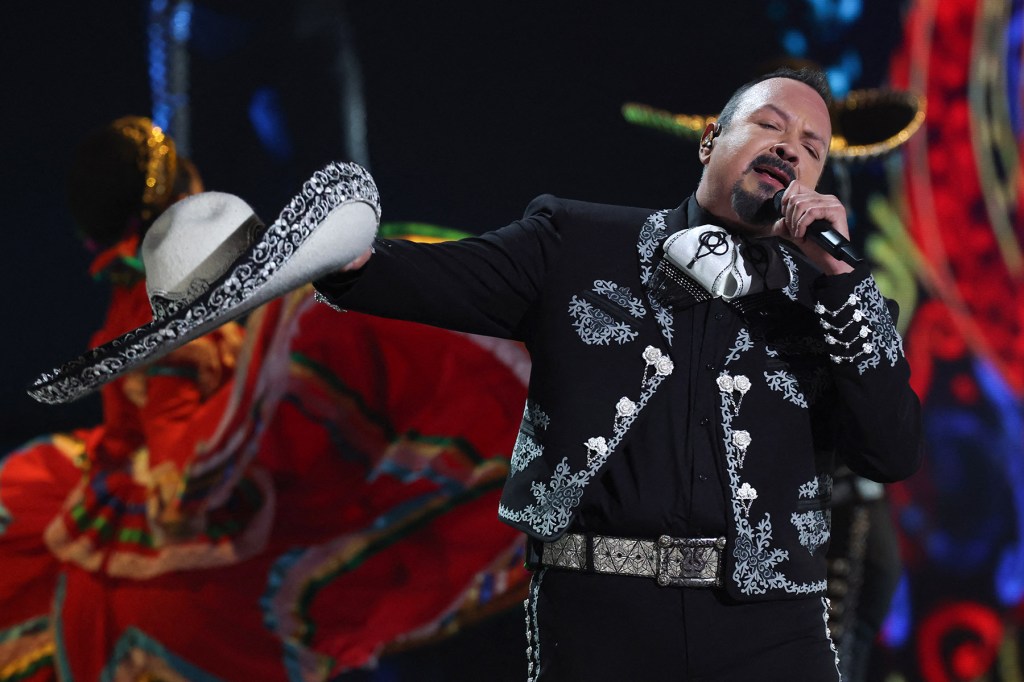Music
Page: 53
Trending on Billboard On the heels of winning best urban song for his heartfelt “DtMF,” Bad Bunny took center stage to perform with Chuwi at the 2025 Latin Grammys on Thursday night (Nov. 13). Their performance kicked off with the emerging Puerto Rican band singing their suave salsa single “Tikiri,” released in 2022. Soon after, […]

Trending on Billboard Nearly naked muscled bodybuilders, towering mountains modeled after a hat, sewing machines and unapologetic Versace flamboyance — this was the vibe at one of the most jaw-dropping performances of the 2025 Latin Grammys on Thursday night (Nov. 13). CA7RIEL y Paco Amoroso turned the stage into a spectacle of pure originality, embracing […]
Trending on Billboard
Raphael was all smiles upon receiving — this time on camera — his 2025 Person of the Year award from the Latin Recording Academy on Thursday night (Nov. 13) during the Latin Grammy Awards ceremony.
After being honored at a star-studded gala the previous eve, the legendary 82-year-old artist took to the stage for a memorable performance, accompanied by more than a dozen musicians who delivered a big band sound. The iconic Spanish singer-songwriter performed classics including “Qué Sabe Nadie” and “Mi Gran Noche” with his characteristic power and interpretive sensitivity.
Raphael, who last year was diagnosed with primary brain lymphoma, looked cheerful and classy in a dark two-piece suit and tie as he accepted his award from Gloria Estefan and Marco Antonio Solís.
“There are artists who have defined decades, and then there’s you, Raphael,” said Estefan, who called the honoree her “personal idol.” Solís added: “With that talent you’ve crossed generations and borders, but that style is something you’re born with.”
Clearly pleased, Raphael accepted the award from his colleagues to a standing ovation from the audience at the MGM Grand Garden Arena in Las Vegas.
“Here it is!” he exclaimed, showing off his trophy. “On this new trip, I’m happy to meet so many friends, both from Spain and from here. Delighted to be here. I solemnly promise I’ll be back.”
“They gave me this last night, and it’s wonderful that I get to hold it today,” he added with a smile. “Thank you so much.”
Considered one of the pioneers in the internationalization of Latin music, Raphael, whose real name is Rafael Martos, was born in Linares in 1943 and raised in Madrid. His talent was evident from an early age, being awarded Best Child Voice in Europe at the age of 9 at the Salzburg Festival. He gained international recognition by representing Spain in Eurovision with songs such as “Toco Madera” (1988), “Maravilloso, Corazón, Maravilloso” (1989) and “Escándalo” (1992), which reached No. 2, 7 and 9 on Billboard‘s Hot Latin Songs chart, respectively. In 2022, he was recognized with the Billboard Lifetime Achievement Award.
The Latin Recording Academy’s Person of the Year award honors musicians for their artistic achievements in the Latin music industry as well as their humanitarian efforts. Raphael joins a list of previous honorees that includes Carlos Vives (2024), Laura Pausini (2023), Marco Antonio Solís (2022), Rubén Blades (2021), Juanes (2019), Maná (2018), Alejandro Sanz (2017), Marc Anthony (2016), Roberto Carlos (2015), Joan Manuel Serrat (2014), Miguel Bosé (2013), Caetano Veloso (2012), Shakira (2011), Plácido Domingo (2010), Juan Gabriel (2009), Gloria Estefan (2008), Juan Luis Guerra (2007), Ricky Martin (2006), José José (2005), Carlos Santana (2004), Gilberto Gil (2003), Vicente Fernández (2002), Julio Iglesias (2001), and Emilio Estefan (2000).
In its 26th edition, the Latin Grammys ceremony is hosted by Maluma and Roselyn Sánchez and broadcast live on Univision. For a full list of winners, click here.
Trending on Billboard DannyLux, Kakalo and Iván Cornejo, three young voices in Mexican music, delivered one of the most heartfelt performances on Thursday (Nov. 13) during the 2025 Latin Grammy Awards ceremony. On a stage decorated solely with blue and white lights, showcasing the most contemporary sounds of the genre, the three artists — who […]
Trending on Billboard Drake quietly parted ways with the booking agent he shared with longtime rival Kendrick Lamar earlier this year, Billboard has learned, in a move largely kept quiet to avoid media scrutiny. One source tells Billboard that Drake and former longtime agent Brent Smith of Wasserman Music have not worked together for most, […]
Trending on Billboard
Karol G and Marco Antonio Solís joined forces on Thursday night (Nov. 13) at the 2025 Latin Grammy Awards to deliver a heartfelt performance of “Coleccionando Heridas.” The Mexican legend and Colombian superstar brought two generations and styles together in a showcase that felt understated yet charming.
Midway through the song, the duo danced, adding a touch of warmth and camaraderie to the stage. Karol kept her look casual yet alluring, styled with jeans, a peach-pink top, and sporting braids adorned with decorative laces, embodying a relaxed persona. Meanwhile, Solís, with a flamboyant flair, contrasted Karol’s simplicity with a bold yellow suit. His silky vocals, paired with Karol’s unique tone, elevated the gentle melody, as they sang the main hook: “Yo seguiré coleccionando heridas.” The duet stood out as a memorable, sweet moment in the broadcast backed by a live ensemble.
The 26th annual Latin Grammy Awards can be seen on Univision, UNIMÁS and ViX. The ceremony features performances from Carlos Santana, Christian Nodal, DannyLux, Rauw Alejandro, Aitana, Fuerza Regida and more.
Bad Bunny leads the nominations this year, topping the list with 12 nods, including album of the year for Debí Tirar Más Fotos and double mentions in the record of the year and song of the year categories for “Baile Inolvidable” and “DTMF.” Hot on his heels are Mexican-American producer-songwriter Edgar Barrera and Argentine duo CA7RIEL & Paco Amoroso, each earning 10 nominations.
This year’s ceremony boasts 60 categories honoring the very best in Latin music. Fans can follow along with all the night’s winners as the list updates live — click here to see who takes home a trophy.
Check out more Latin Grammy coverage, including performance highlights, special award moments, and exclusive behind-the-scenes action on Billboard.com.
Trending on Billboard Pepe Aguilar, a Mexican artist who can traverse many genres – from traditional ranchera to progressive pop — went for tradition in his 2025 Latin Grammys performance. Singing with the backing of a 16-piece mariachi, Aguilar belted “El Cihualteco” and “El Fuereño,” from his album Mi Suerte Es Ser Mexicano, nominated for […]

Trending on Billboard Rauw Alejandro proved why he remains one of Latin music’s most dynamic performers on Thursday (Nov. 13) night at the 26th annual Latin Grammy Awards. Taking the stage with his smooth vocals and jaw-dropping choreography, the Puerto RIcan superstar delivered a medley that showcased his ability to effortlessly transition between genres, from tropical […]
Trending on Billboard
Cardi B has welcomed her new baby boy with boyfriend Stefon Diggs, the rap superstar announced Thursday (Nov. 13) on Instagram.
This is Cardi’s fourth child, following her trio of kids with ex-husband Offset: 7-year-old daughter Kulture, 4-year-old son Wave, and 1-year-old daughter Blossom.
Cardi shared the news in the caption of an Instagram video soundtracked by her song “Hello,” from her Billboard 200-topping sophomore album Am I the Drama?, which arrived in September.
“My life has always been a combination of different chapters and different seasons,” she wrote in part in the lengthy caption. “My last chapter was the beginning of a new season. Starting over is never easy but it’s been so worth it! I brought new music and a new album to the world! A new baby into my world, and one more reason to be the best version of me, one more reason to love me more than anything else or anyone else so I can continue giving my babies the love and life they deserve. This next chapter is Me vs. Me!”
In a video posted to her Instagram Story, Cardi confirmed the sex of the baby, fawning over a girly, flower-covered stroller and lamenting, “I just had a boy … why didn’t I know about this [stroller] last year?”
While whispers of their relationship started in the fall of last year, Cardi and New England Patriots player Stefon Diggs made their first public outing as a couple in May, cuddling up courtside at the New York Knicks vs. Boston Celtics game during the 2025 NBA Playoffs. Cardi announced their pregnancy news in September, telling CBS Mornings: “I feel very powerful that I’m doing all this work. But I’m doing all this work while I’m creating a baby, and me and my man, we’re very supportive of each other.”
In the Instagram caption, Cardi referenced her 2026 Little Miss Drama tour, which kicks off Feb. 11 in Palm Desert, California. “I’ve started prepping for tour getting my body right getting my mind right,” she wrote. “There’s nothing thats gonna stop me from giving you guys the performance of a life time! I’ve learned i’ve healed, and im loving the woman i’ve become! Thats what this next era means to me and i’m stepping into it better than ever.”
See her announcement below:
Trending on Billboard Florence + the Machine’s latest studio album Everybody Scream makes noise on Billboard’s album charts (dated Nov. 15), debuting at No. 1 on Top Rock & Alternative Albums, Top Rock Albums, Top Alternative Albums, Top Album Sales, Top Current Album Sales and Indie Store Album Sales. It also launches at No. 4 […]

 State Champ Radio
State Champ Radio 








